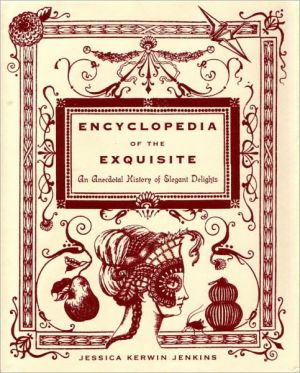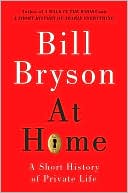Encyclopedia of the Exquisite: An Anecdotal History of Elegant Delights
Encyclopedia of the Exquisite is a lifestyle guide for the Francophile and the Anglomaniac, the gourmet and the style maven, the armchair traveler and the art lover. It’s an homage to the esoteric world of glamour that doesn’t require much spending but makes us feel rich.\ Taking a cue from the exotic encyclopedias of the sixteenth century, which brimmed with mysterious artifacts, Jessica Kerwin Jenkins’s Encyclopedia of the Exquisite focuses on the elegant, the rare, the commonplace, and the...
Search in google:
Encyclopedia of the Exquisite is a lifestyle guide for the Francophile and the Anglomaniac, the gourmet and the style maven, the armchair traveler and the art lover. It’s an homage to the esoteric world of glamour that doesn’t require much spending but makes us feel rich. Taking a cue from the exotic encyclopedias of the sixteenth century, which brimmed with mysterious artifacts, Jessica Kerwin Jenkins’s Encyclopedia of the Exquisite focuses on the elegant, the rare, the commonplace, and the delightful. A compendium of style, it merges whimsy and practicality, traipsing through the fine arts and the worlds of fashion, food, travel, home, garden, and beauty. Each entry features several engaging anecdotes, illuminating the curious past of each enduring source of beauty. Subjects covered include the explosive history of champagne; the art of lounging on a divan; the emergence of “frillies,” the first lacy, racy lingerie; the ancient uses of sweet-smelling saffron; the wild riot incited by the appearance of London’s first top hat; Julia Child’s tip for cooking the perfect omelet; the polarizing practice of wearing red lipstick during World War II; Louis XIV’s fondness for the luscious Bartlett pear; the Indian origin of badminton; Parliament’s 1650 attempt to suppress Europe’s beauty mark fad; the evolution of the Japanese kimono; the pilgrimage of Central Park’s Egyptian obelisk; and the fanciful thrill of dining alfresco. Cleverly illustrated, Encyclopedia of the Exquisite is an ode to life’s plenty, from the extravagant to the eccentric. It is a celebration of luxury that doesn’t necessarily require money. The Barnes & Noble Review It might be easy to dismiss this book as a trifle, and matters aren't helped by rococo illustrations and blurbs on the dust jacket from such literary authorities as Sarah Jessica Parker and the designer Michael Kors. But if the form of Encyclopedia of the Exquisite plays up its author's insouciance, the text itself nevertheless carries a surprising authority. Entries can jump across centuries and disciplines: the section on "Enthusiasm" harvests ideas from Hobbes, Diderot, Shelley, Blake, Wordsworth, and Germaine de Staël. And Kerwin Jenkins provides a 40-page bibliography, set in eye-straining type -- this must be the only book to cite both Harvard's Henry Louis Gates Jr. and Vogue's Diana Vreeland.
Champagne\ Sparkling white wine from the French region of Champagne\ \ At the coronation of the sisteen-year-old Louis XIV (1638–1715), one of the locals at Reims, the capitol of the Champagne region, told the new king, “Sire, we offer you our wines, our pears, our gingerbreads, our biscuits, and our hearts.” “That, gentlemen,” the cocky new king replied, “is the kind of speech I like.”\ What he didn’t like, however, were bubbles in his wine, thought to be a flaw in the fermenting process until the blind Benedictine monk Dom Pierre Pérignon (1638–1715) gave sparkling champagne its big start, regulating the effervescence when he couldn’t get rid of it. All wines bubble naturally when the grapes are first pressed, but in colder regions, like Champagne, the yeasts that cause fizzing hibernate during the winter, waking up again in the spring to bubble anew. Champagne’s wine came to life in March, and by summertime it was “en furie.”\ Because the highly pressurized bottles shattered at the slightest provocation, champagne’s prices soared. Winemakers sidled into their cellars wearing iron masks as a protection against exploding glass. One vineyard owner was left with just 120 bottles out of 6,000 after the rest were blown to smithereens in 1746.\ Its explosive property aside, champagne wasn’t an easy sell in the beginning. One winegrower proclaimed that froth was only appropriate in “beer, chocolate, and whipped cream.” Doctors expounded on the dangers of drinking champagne. Others, such as professor Benigné Grenan, issued warnings in verse:\ Lift to the skies thy foaming wine,\ That cheers the heart, that charms the eye,\ Exalt its fragrance, gift divine,\ Champagne, from thee the wise must fly!\ A poison lurks those charms below,\ An asp beneath the flowers is hid.\ \ Nevertheless, fizzy fans like Madame de Pompadour loved the delicacy of the drink. As Voltaire (1694–1778) put it, “This wine where sparkling bubbles dance/Reflects the brilliant soul of France.” The Faculty of Medicine of Paris finally ruled in champagne’s favor.\ A good champagne, like those blended by Krug, is feathery with small bubbles and complex, revealing a taste that is tart like a green apple, flowery with roses and violets, sweet like roasted pineapple, and toasty as a golden brioche.\ Technical advances kept bottles from bursting during the nineteenth century, which should have lowered prices, but by then champagne was draped in a luxe legend all its own. Its bubbles were synonymous with celebration, and were required to toast any important moment, from the launching of a boat to a marriage or the birth of a child.\ Its pull was so strong that even Stalin couldn’t resist. Under his guidance, Professor Frolov-Bagraev launched Soviet champagne—Sovetskoe shampanskoe—in Russia in the mid-1930s. Cheaply mass-produced, sugary, and still available today, it offered workers of all walks a sickly-sweet taste of the good life.\ Milk Baths\ Bathing in a tub of milk, instead of water\ While scholars doubt that Emperor Nero actually fiddled as Rome burned—it seems more likely that he sang—few question the legend of his infamously licentious wife Poppaea’s milk-based beauty regime. The mules pulling her carriage may have been decked with gold, but Poppaea (AD 30–65) is remembered for the herd of four hundred asses whose milk filled her daily bath.\ Forever after, soaking in milk demonstrated a debauched sensuality. Following in Poppaea’s footsteps, Napoleon’s favorite sister, Princess Pauline Bonaparte Borghese (1780–1825), a notorious pleasure seeker who once asked a lady-in-waiting to lie on the floor and expose her bosom so that the princess could warm her feet there (or so the story goes), was carried by her servant Paul to and from her daily hot milk bath, which she followed with a cold milk shower.\ Almost a century later, regal sizzle was just the tone showman Florenz Ziegfeld hoped to strike when importing Parisian chanteuse Anna Held (1872–1918) to Broadway. Held, a genuine tease, sang numbers such as “Come Play wiz Me,” in Ziegfeld productions like La Poupée, The French Maid, and Mam’selle. But it was her milk baths that made Held a household name.\ A month after her 1896 debut, newspapers reported that H. R. Wallace, a Long Island milkman, was suing Held for sixty-four dollars—the money she owed for the forty gallons of milk he delivered to her hotel every other day so she could bathe in it. The gist was that she refused to pay because the milk wasn’t fresh, though her publicist told reporters the parties would settle out of court, as “milk baths were too peculiar to be discussed in public.” The papers—and the public—went wild, and by the time story was discovered to be a Ziegfeld-crafted hoax, Held was a star. She wore giant jewels and an impossibly cinched corset, doled out beauty tips to Vogue, and became Ziegfeld’s common-law wife.\ Claudette Colbert (1903–1996), another French-born siren, picked up where Held left off. At the beginning of her career, she came across as plucky, likable, and cute, jumping from Broadway to Hollywood during the Depression to star in a string of fluffy comedies—until 1932, when director Cecil B. DeMille asked if she’d like to play “the wickedest woman in the world” in Sign of the Cross, his over-the-top epic depicting the plight of pious Christians in Nero’s ancient Rome. And her Poppaea was wicked. In the film’s lustiest scene, Colbert, just millimeters shy of baring her bosom, lolled in a black marble tub of what’s meant to be asses’ milk, when one of the ladies of her imperial retinue dropped by with some gossip. “Take off your clothes, get in here and tell me about it,” came Colbert’s purring command.\ No one could have guessed that Colbert’s bath—full of Klim, a powdered milk solution (milk spelled backward)—had curdled, literally, under the set’s big movie lights. It wasn’t Cobert’s last on-screen bath. The racy tub scene hastened enforcement of Hollywood’s decency standards, the Production Code, cooling things off considerably for the next two decades, but DeMille’s Cleopatra (1934) came in just under the legal wire, starring Colbert as another ancient diva who, in the name of pleasure and beauty, took yet another seminude, milky dip.\ Obelisk\ A monumental, monolithic column of stone\ At the entrances to their majestic temples ancient Egyptians constructed mammoth hieroglyphic-covered stone monoliths, obelisks, honoring their gods and pharaohs. Each weighed hundreds of tons and stood as high as one hundred feet tall. But since the days of Augustus Caesar, their massive size never stopped foreign visitors from hauling them away like so many cumbersome souvenirs. Among the forty-eight obelisks the Roman emperors swiped, thirteen are still standing, including the red granite spike in front of St. Peter’s basilica at the Vatican, imported by Caligula in the first century.\ When Pope Sixtus V (1521–1590) decided to move the Vatican’s obelisk to its present spot in 1586, five hundred engineers and architects competed for the honor of orchestrating the maneuver. Architect Domenico Fontana landed the job. He sent for rope, horses, buffalo, timber, and man power from across Italy, constructing an elaborate cranelike apparatus to coax the monument into place. On the big day, a silent crowd filled the surrounding streets and rooftops, waiting. The pope had issued an edict that anyone who spoke, or spat, during the proceedings would suffer severe consequences, as Fontana would use a trumpet and a bell to signal the scores of workers with coded commands.\ Two masses were said in the cathedral before they began. Sixtus performed a benediction over Fontana, but also, for good measure, warned him that if anything went wrong he would lose his head. Obelisks were valuable and they broke all too easily, as evidenced by Rome’s shattered mistakes, still lying where they landed. (The Egyptian ruler Ramses let workers know the value of an obelisk by having his son tied to the pinnacle before they moved it.) Sixtus, however, was more lenient than he seemed. Secretly, he ordered a horse made ready so that Fontana could escape him—and the crowd—if things went wrong. But it was an unnecessary precaution. Fontana’s scheme worked, and it made him rich, though he did set the obelisk just slightly off center, an awkward geometry that a later architect tried to correct by building St. Peter’s slightly askew.\ After Napoleon’s campaign in Egypt, obelisk fever struck again in the nineteenth century. The French carried off one from the temple at Luxor in 1836, raising it in Paris’s Place de la Concorde. The English snapped up a fallen Alexandrian obelisk in 1877, putting it up in London. The Americans set their sites on an obelisk originally erected by Thutmose III outside of Cairo, and which Augustus Caesar had floated down the Nile to Alexandria around 10 BC. The Egyptian government offered it to the United States as a diplomatic gesture. “It would be absurd for the people of any great city to be happy without an Egyptian Obelisk,” commented the New York Herald. “If New York was without one, all those great sites might point the finger of scorn at us and intimate that we could never rise to any real moral grandeur until we had our obelisk.”\ While no one in Egypt seemed to mind when all the other obelisks left their shores, the American obelisk was one too many. The Egyptians protested its removal, and in the United States Americans petitioned against installing the thing, a strange object which newspapers depicted as an inexplicable extravagance. Outside the telegraph office in Alexandria, the American engineer in charge of transporting the monument faced “a storm of hisses and a succession of choice epithets,” he wrote. He quickly draped an American flag around the stone, staking his claim, and set crews to work day and night to get it onto a steamer ship and out of Egypt, an expensive undertaking funded by William Vanderbilt.\ On the other side of the water, the New York Sun called the obelisk “terrific humbug,” and “only a broken, decaying and disfigured old block of stone.” But finally, after a risky ocean crossing, as gangs of men and horses struggled and strained for weeks on end, inching the thing off the boat and down Manhattan’s snowy streets, the American press and the public rallied around the pillar and its odyssey. “There is no longer any hope that we shall escape the Alexandria obelisk,” the New York Times reported. It was erected in 1881 in Central Park next to the Metropolitan Museum of Art with great pomp and ceremony “as a monument to—nobody knows what.”\ Red Lipstick\ Red paint for the lips\ For millennia, red lipstick has been both treasured and forbidden. Its appeal is primal, offering a vivid shortcut to glamour. Ancient Romans painted their lips with vermillion, though their rulers tried to ban it. Elizabethans used tinted red alabaster, though an edict proclaimed that any woman found wearing it “shall be punished with the penalties of witchcraft.” Strict Puritans and Victorians felt likewise. But few moments in history have united so many in favor of red lips as World War II, when in the Allied countries’ vanity stood defiant in the face of adversity.\ Lipstick was rationed in England in order to conserve glycerin to make explosives, but in the United States lipstick production continued throughout the war, packaged in polished cardboard in order to save brass. As an American War Production Board spokesman explained, a woman’s “resultant vivacious spirit, self-confidence and geniality” was infectious, “to be transmitted directly to the male members of the family.” It was a question of morale. Psychiatrists called lipstick “an essential nonessential,” and a pamphlet written for the Marine Corps told female recruits that their lipstick and nail polish should match “the scarlet hat cord” of their uniform.\ On the other side, the Nazi Party banned lipstick as early as 1933, announcing that “women with painted faces” would not be admitted to party functions, according to the New York Times. “The German woman must revert to the type of the Germanic mother,” a party official said. “The German girl must prepare herself for becoming worthy of this honor.”\ The German ban on lipstick was news in the United States, but the press was fixated on England’s lack of the stuff. Americans sent tubes in care packages for women in the British armed forces. For their part, English women who stayed at home melted down the stubs of their lipsticks to make them last. In her diary, a fifty-year-old Cumbrian housewife named Nella Last (1889–1968) pondered the potency of lipstick and its role in her own transformation after her son left for the front. “I contrast the rather retiring woman who had such headaches, and used to lie down so many afternoons with the woman of today who can keep on and will not think; who coaxes pennies where she once would have died rather than ask favours,” she wrote in 1939, “who uses too bright a lipstick and on dim days makes the corners turn up when lips will not keep smiling.”
\ Lily Koppel…a cabinet of curiosities—in book form—inspired in part by the encyclopedias of the Renaissance, which brimmed with exotic artifacts…[Jenkins's] encyclopedia is sensual and dainty…with entries on diverse and beguiling subjects…Jenkins's wittily curated selection emphasizes the rare and not often considered, with a dash of Julie Andrews's "favorite things" sensibility…It is a worthy trove.\ —The New York Times\ \ \ The Barnes & Noble ReviewNot everything elegant is expensive; not everything expensive is elegant. Making a list of costly, trashy things is easy: leopard-skin rugs, yachts with bulletproof glass, Jeff Koons's paintings, Monte Carlo. But discovering elegance in modest or everyday sources, especially in the face of a multibillion-dollar luxury industry, takes more doing. That is the subject of Jessica Kerwin Jenkins's Encyclopedia of the Exquisite, a deceptively light survey of "uncommon delicacies, carefully selected." Kerwin Jenkins, formerly an editor at W and now a writer for Vogue, wants us to do away with the "luxe fantasy" (pushed in part by those same magazines, of course) and find wonder in the "obscure, exquisite, and twinkling" pleasures she has compiled, alphabetically.\ Many of Kerwin Jenkins's favorite things come from Europe, particularly France, in the eighteenth and nineteenth centuries. In the section entitled "Divan," she looks at "the illicit pleasures of reclining" through the novel Les Liaisons Dangereuses and the paintings of Manet -- reclining, she says, is a "suspect" in-between state that suggests decadence or immorality. There is a hilarious entry on the pouf, the hairstyle favored by Marie Antoinette, who incorporated in her towering beehive accessories from sheaves of wheat to a replica of a battleship. (Kerwin Jenkins observes that, while elegant, the pouf was a tough look to master: it made sleeping difficult, and the hair could become infested with vermin, against which women wielded "ivory scratching sticks designed to plunge into the hair-covered hives.") And like any good fashionista, the author demonstrates a complete reverence for Japan and its aesthetics: we get commentary on folding fans, the kimono, the tea ceremony, origami, the art of food arrangement, and even an in-depth look at the 10th-century diarist Sei Shonagon, whose Pillow Book, a compendium of miscellaneous thoughts and lists of beautiful things, might be a model for Kerwin Jenkins's own work.\ Yet other amusements are found closer to home. Busby Berkeley musicals are one: the author is enraptured by the dozens of chorines who "sprang from a sea of white ostrich feathers wearing wispy feathered bikinis," and relieved that his maximalist vision endures on the soundstages of Bollywood. In a section on "Heels" she reveals how Marilyn Monroe would cut a quarter-inch off one of her shoes to give her walk its signature hip-swaying allure. Some of the most charming sections of the book aren't historical at all, but general takes on small pleasures -- pears, crickets, clouds, the color black. Best of all is the section on far niente, the Italian art of idleness; puritans may object, but Kerwin Jenkins is right when she praises "the languorous sweetness of doing nothing at all."\ It might be easy to dismiss this book as a trifle, and matters aren't helped by rococo illustrations and blurbs on the dust jacket from such literary authorities as Sarah Jessica Parker and the designer Michael Kors. But if the form of Encyclopedia of the Exquisite plays up its author's insouciance, the text itself nevertheless carries a surprising authority. Entries can jump across centuries and disciplines: the section on "Enthusiasm" harvests ideas from Hobbes, Diderot, Shelley, Blake, Wordsworth, and Germaine de Staël. And Kerwin Jenkins provides a 40-page bibliography, set in eye-straining type -- this must be the only book to cite both Harvard's Henry Louis Gates Jr. and Vogue's Diana Vreeland.\ It's a paradox: the greatest pleasure of this ode to frivolity is the author's own diligence. Encyclopedia of the Exquisite may eulogize the pointless in this era of industry, our noses pressed to grindstones or BlackBerries -- and yet idleness, and the elegance that can arise from that state, turn out to be very hard work.\ --Jason Farago\ \ \








